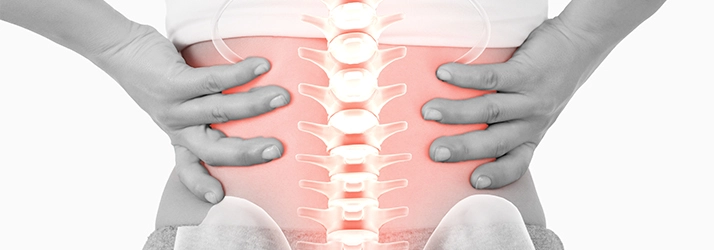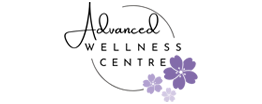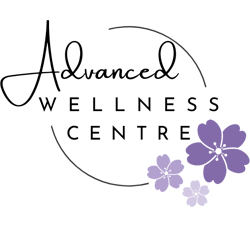Degenerative Disc Disease, Spondylosis & Stenosis, Disc Injuries in Ottawa ON

There are several degenerative diseases of the spinal column that can be helped with chiropractic care, physical therapy, and/or acupuncture before surgery is required. Contact our Ottawa chiropractic clinic today to learn more.
Degenerative disc disease (DDD) in Ottawa ON
Degenerative disc disease (DDD), also known as degenerative disc disorder, is a medical condition that primarily affects the intervertebral discs of the spine. Our spinal discs are soft, cushion-like structures located between the vertebrae (the bones of the spine) that act as shock absorbers and allow for flexibility in the spine.
Healthy discs are thicker, stronger, and more flexible, while degenerated discs are thinner, weaker and less flexible. Sometimes, they put pressure on the nerve along the spinal column.
DDD is a progressive condition that occurs when the intervertebral discs gradually break down or degenerate over time. This degeneration can result from a combination of factors, including:
- Aging: DDD is commonly associated with the natural aging process. As people get older, their discs lose water content and become less flexible, making them more susceptible to damage.
- Wear and Tear: Repetitive movements, heavy lifting, poor posture, excessing sitting, and other factors that put stress on the spine can contribute to the wear and tear of the discs.
- Genetics: Some individuals may be genetically predisposed to develop DDD.
- Trauma: Injuries or trauma to the spine, such as from accidents or falls, can accelerate the degeneration of the discs.
- Smoking: Smoking has been linked to an increased risk of developing DDD, as it may impair the blood supply to the discs.
Nearly every physical activity can place a strain upon our spinal discs. Sitting especially can put strain on the lumbar spine (lower back). Over time, repeated daily stress and minor traumas can begin to weaken the discs of the spine. This process of accumulated wear and tear will eventually lead to disc degeneration, especially if the joints are not aligned properly or are not moving properly.
Some natural solutions to degenerative disc disease, stenosis, sciatica, thoracic outlet syndrome and sciatica include:
- Chiropractic Care
- Acupuncture Treatment
Symptoms of Degenerative Disc Disease
The most common symptoms of degenerative disc disease (DDD) can vary depending on the location and severity of the disc degeneration, but they typically include:
- Chronic Back Pain: Persistent, dull, or aching pain in the lower back (lumbar DDD) or neck (cervical DDD) is a hallmark symptom. The pain may come and go or be constant, and it often worsens with movements like bending, lifting, or twisting.
- Pain That Radiates: DDD can lead to radiculopathy, where the degenerated discs press on nearby nerve roots. This can cause pain, tingling, numbness, or weakness that radiates into the arms or legs, depending on the location of the affected discs. In lumbar DDD, this is often referred to as sciatica when it affects the lower limbs.
- Worsened Symptoms with Activity: Physical activity and certain movements can exacerbate the pain associated with DDD. This includes activities like lifting heavy objects, bending over, or sitting for extended periods.
- Stiffness: Many individuals with DDD experience stiffness in the affected area, which can make it challenging to perform everyday tasks or find a comfortable position.
- Decreased Range of Motion: As the discs degenerate, they can limit the range of motion in the spine, making it difficult to bend, twist, or turn as freely as before.
- Muscle Weakness: In advanced cases or when nerve compression is severe, DDD can lead to muscle weakness in the affected area. This can affect one's ability to perform certain activities or maintain proper posture.
The most serious problem related to Degenerative Disc Disease is direct nerve compression. This occurs when the spinal disc becomes thinner, also called disc height reduction, and causes the space between the bones to narrow. This narrowing also makes the hole between the nerves smaller as well. Neural Foraminal Narrowing causes direct bone-on-nerve compression which can create such severe and debilitating symptoms as sharp pain, burning, numbness, tingling and muscle weakness. Over time, this degenerative process can compromise the nerve to the point that the organs controlled by these nerves can become diseased. Therefore, the most serious issues associated with Degenerative Disc Disease are not due to the disc itself, but how the disc degeneration causes the nerves to become injured over time, leading to issues beyond the disc itself.
It's important to note that not everyone with degenerative disc disease experiences the same symptoms, and the severity of symptoms can vary widely among individuals. Additionally, some people may have DDD and be asymptomatic, meaning they don't experience noticeable pain or discomfort.
Spinal Stenosis
Spinal stenosis is characterized by the narrowing of the spinal canal or the spaces within the spine. This narrowing can put pressure on the spinal cord and nerves, leading to a range of symptoms. There are two main types of spinal stenosis:
- Lumbar Spinal Stenosis: This is the most common type of spinal stenosis and occurs in the lower back. It often develops because of degenerative changes in the spine associated with aging. The narrowing of the spinal canal in the lumbar region can compress the nerves that extend into the legs. Common symptoms of lumbar spinal stenosis include pain, weakness, numbness, or tingling in the lower back and legs. These symptoms often worsen when standing or walking and may improve when sitting or bending forward.
- Cervical Spinal Stenosis: This type of spinal stenosis affects the neck area. It can result from degenerative changes in the cervical spine, as well as other conditions such as herniated discs or bone spurs. Common symptoms of cervical spinal stenosis may include neck pain, weakness, numbness, or tingling in the arms and hands. In severe cases, it can lead to problems with balance, coordination, and bladder or bowel function.
The symptoms of spinal stenosis can vary in severity, and some individuals may experience only mild discomfort or none at all. However, as the condition progresses or if there is significant nerve compression, it can lead to more significant pain and functional limitations.
Chiropractic for Stenosis, Spondylosis, and Degenerative Disc Disease
Chiropractic care is a complementary and alternative treatment approach that focuses on diagnosing and managing musculoskeletal disorders, including those related to the spine. While some people with spinal stenosis report finding relief through chiropractic treatment, it's essential to understand that the effectiveness of chiropractic care for spinal stenosis can vary from person to person. Here are some ways in which chiropractic care may be considered as part of a treatment plan for spinal stenosis:
- Pain Management: Chiropractors often use various techniques, including spinal adjustments or manipulations, to relieve pain associated with spinal stenosis. These adjustments aim to improve the alignment of the spine, reduce nerve compression, and alleviate discomfort.
- Improving Range of Motion: Chiropractic adjustments and therapeutic exercises may help improve the range of motion in the affected area of the spine. This can be particularly beneficial for individuals with spinal stenosis, as limited movement is a common symptom.
- Physical Therapy: Chiropractors may incorporate physical therapy techniques into their treatment plans. This can include exercises to strengthen the muscles that support the spine and improve overall spinal function.
- Posture and Ergonomics: Chiropractors often provide guidance on proper posture and ergonomics, which can be crucial for individuals with spinal stenosis. Learning how to sit, stand, and move in ways that minimize strain on the spine can help manage symptoms and prevent exacerbation.
- Pain Reduction and Inflammation Control: Chiropractic care may include modalities such as electrical stimulation or ultrasound to help reduce pain and inflammation in the affected area.
It's important to note that while some individuals with spinal stenosis may experience relief from acupuncture or chiropractic care, the effectiveness of these treatments can vary widely. Chiropractic care is generally considered safer than surgery or certain medical interventions and is often used as a conservative treatment approach. However, it's crucial to consult with your healthcare professional before pursuing chiropractic care for spinal stenosis, especially if you have a severe/advanced case of spinal stenosis or have other underlying health conditions.
Acupuncture for DDD, Stenosis, Spondylosis
Acupuncture is a complementary therapy that is rooted in traditional Chinese medicine. While the effectiveness of acupuncture for spinal stenosis is not conclusively proven, some individuals with this condition have reported experiencing symptom relief and improved quality of life through acupuncture treatment. Here are some ways in which acupuncture may potentially help with spinal stenosis:
- Pain Relief: Acupuncture is often used as a natural pain management approach. Thin needles are inserted at specific acupuncture points on the body to stimulate the release of endorphins, the body's natural painkillers. This can help reduce pain associated with spinal stenosis.
- Muscle Relaxation: Acupuncture may help relax tense muscles around the affected area of the spine. Muscle tension is a common response to pain and can exacerbate the symptoms of spinal stenosis. By promoting muscle relaxation, acupuncture may reduce discomfort and improve mobility.
- Inflammation Reduction: Some research suggests that acupuncture may have anti-inflammatory effects. By reducing inflammation in the spinal canal or the surrounding tissues, acupuncture may alleviate some of the symptoms of spinal stenosis.
- Improved Circulation: Acupuncture is believed to enhance blood flow in the body. Improved circulation can promote the delivery of nutrients and oxygen to the affected area, potentially aiding in the natural healing process.
- Stress Reduction: Chronic pain conditions like spinal stenosis can lead to stress and anxiety. Acupuncture sessions are often accompanied by relaxation and stress reduction, which can contribute to an improved overall sense of well-being.
It's important to note that acupuncture is generally considered safe when performed by a trained and licensed practitioner who uses sterile needles and follows proper hygiene procedures. However, individual responses to acupuncture can vary, and not everyone with spinal stenosis will experience the same level of relief or benefit from this therapy.
If you are considering acupuncture as part of your treatment plan for spinal stenosis, it's crucial to consult with your healthcare provider. They can help you determine whether acupuncture is a suitable complementary therapy for your specific condition and provide guidance on its potential benefits and limitations. Acupuncture is often used in conjunction with other conventional treatments as part of a comprehensive approach to managing spinal stenosis symptoms.
Disc Injuries
There are several words for a problem with a spinal disc: slipped disc, bulging disc, herniated disc, protruding discs, prolapsed disc, ruptured disc. All of these descriptions refer to the injury to the fibers or internal structure of the spinal disc.
When the spinal joints become stuck, or less mobile from spinal subluxation, the discs do not get blood flow and nutrients they need. This causes the accumulation of waste materials because the disc fluid cannot circulate well from the lack of spinal joint mobility (like when you turn the filter pump off to your pool, and the stagnant water turns green with gunk accumulating). This lack of circulation of fluids and blood flow and nutrients can cause the discs to degenerate faster. This sets the stage for disc degeneration and can make it easier to create further disc injury.
When a disc is injured, its delectate fibers are damaged or torn. This can allow the soft nucleus in the center of the disc to shift or essentially ooze toward the outer edges of the disc. Think of this as kind of like the jelly inside a jelly donut oozing to outside when it’s squished.
Disc injuries can occur suddenly or slowly over time. The problem is that the spinal cord and spinal nerves are very close to the disc and can get pressure exerted upon them when a spinal disc injury such as a “slipped disc” or herniated disc. This can create severe pain such as sciatica or pain down the arm or leg or numbness.
Fortunately, chiropractic care often provides excellent relief of pain from disc injury. Chiropractic also helps to restore mobility to the spinal joints, thereby reducing disc inflammation and aiding in the healing of injured discs.
Disc injuries can be exceedingly painful. If you are suffering from disc pain, call us today and we will find a time to see you as soon as possible.
What is Spinal Subluxation?
Another term important to understand in the diagnosis of a herniated disc is subluxation. Subluxation is when one or more of the bones of your spine (vertebrae) move out of position. The result can be a herniated disc. If this creates pressure on spinal nerves, problems will result. This pressure or irritation on the nerves causes the nerves to malfunction and interfere with the signals traveling over those nerves.
A Doctor of Chiropractic or Chiropractor is trained to locate subluxations and reduce or correct them. This can be accomplished through a series of chiropractic adjustments designed to correct the vertebral subluxations in your spine. Chiropractors are the go-to professionals with years of training and expertise for correcting spinal subluxations. There are many safe chiropractic methods to decompress the vertebrae which allow the disc the ability to heal itself.
Spondylosis, Spinal Osteoarthritis, Facet Joint Syndrome, Degenerative Joint Disease of the Spine
Spondylosis, also known as spinal osteoarthritis or degenerative joint disease of the spine, is a common age-related condition that affects the spine's vertebral discs and facet joints. It is characterized by degeneration, wear and tear, and changes in the spine's structures over time. Spondylosis typically occurs in older adults and is a natural part of the aging process. It can affect any region of the spine, including the cervical spine (neck), thoracic spine (mid-back), and lumbar spine (lower back).
Facet joint syndrome, also known as facet joint osteoarthritis or facet joint arthritis, is a condition that affects the facet joints of the spine. The facet joints are small joints located between the vertebral bones of the spine. They play a crucial role in the spine's stability and enable movements like bending, twisting, and turning. Facet joint syndrome occurs when these joints become inflamed, degenerate, or experience excessive wear and tear, often due to aging or repetitive strain. This can lead to a range of symptoms and discomfort in the affected area of the spine.
Key features of these spinal joint disorders include:
- Disc Degeneration: Over time, the intervertebral discs, which act as cushions between the vertebrae, lose water content and become thinner. This can lead to a reduction in the disc's ability to absorb shock and distribute pressure in the spine.
- Bone Spurs (Osteophytes): As a response to the changes in the discs and the increased stress on the spine, the body may form bony growths called osteophytes or bone spurs. These spurs can develop along the edges of the vertebral bones and the facet joints.
- Facet Joint Changes: Spondylosis can involve degeneration of the facet joints, which are small joints that connect adjacent vertebrae. As these joints wear down, they may become inflamed and painful.
Common symptoms can include:
- Chronic Neck or Back Pain: Individuals with spondylosis often experience persistent pain in the affected area of the spine. The pain can range from mild to severe.
- Stiffness: Reduced flexibility and stiffness in the spine are common symptoms, which can limit range of motion.
- Radiating Pain: If bone spurs or degenerated discs press on nearby nerves, it can lead to radiating pain, numbness, tingling, or weakness in the arms or legs, depending on the location of the spondylosis.
- Muscle Weakness: In advanced cases, spondylosis can cause muscle weakness in the affected area.
These types of joint degenerative diseases are typically diagnosed through a combination of medical history, physical examination, and imaging studies like X-rays, CT scans, or MRI scans. Treatments may focuses on managing symptoms depending on the severity of the degeneration. Often, the first treatment is to help manage pain.
Monday
4:00pm - 6:00pm
Tuesday
11:00am - 2:00pm
3:30pm - 6:00pm
Wednesday
11:00am - 2:00pm
3:30pm - 6:00pm
Thursday
11:00am - 2:00pm
Friday
Closed
Saturday
12:00pm - 3:00pm
Sunday
Closed
Advanced Wellness Centre
200 Metcalfe St Main Floor
Ottawa, ON K2P 1P7
SMOKE FREE
Please do not smoke within one hour of your appointment.
SCENT FREE
Please keep the air we share fragrance and scent-free.
FREE PATIENT PARKING
Evenings after 5:30pm, Weekends & 3 Reserved Spots in front.




